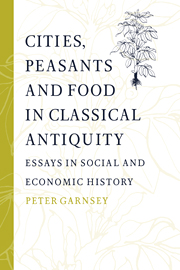Book contents
- Frontmatter
- Contents
- Preface
- Editor's preface
- Acknowledgements
- List of abbreviations
- PART I CITIES
- PART II PEASANTS
- PART III FOOD
- 11 Grain for Athens
- 12 The yield of the land in ancient Greece
- 13 The bean: substance and symbol
- 14 Mass diet and nutrition in the city of Rome
- 15 Child rearing in ancient Italy
- 16 Famine in history
- Bibliography
- Index
12 - The yield of the land in ancient Greece
Published online by Cambridge University Press: 02 December 2009
- Frontmatter
- Contents
- Preface
- Editor's preface
- Acknowledgements
- List of abbreviations
- PART I CITIES
- PART II PEASANTS
- PART III FOOD
- 11 Grain for Athens
- 12 The yield of the land in ancient Greece
- 13 The bean: substance and symbol
- 14 Mass diet and nutrition in the city of Rome
- 15 Child rearing in ancient Italy
- 16 Famine in history
- Bibliography
- Index
Summary
INTRODUCTION
To inquire into the yield of the land in ancient Greece is to pursue a phantom. We need to know, essentially, production totals, area under cultivation, sowing rate for the major crops, in the various regions of Greece, over an extended period of time – in the course of which the natural and social environment did not stand still.
The data do not exist. This is not only because of the disappearance of private records and public documents and the non-survival of treatises of agronomy – we have several such treatises from Italy and are not much wiser for that on the issues in question. The ancients were uninterested in assembling the data we require. Worse still, they lacked key economic concepts like productivity, that is, the ratio of output over input. Or so it would seem.
What can be done, given this evidential blackout? A study of yield-related concepts would have value, in introducing us to the mentality of landowners from antiquity. There is scattered information for farming practices bearing on yield. We can also ask how far comparative evidence can fill the information gap. These matters are discussed in reverse order below.
But I begin by considering one direct piece of ancient evidence for yield, the First Fruits inscription from Eleusis dated to 329/8, IG II2,1672. I have previously discussed this inscription without, however, facing possible objections to its use for the purposes in question.
- Type
- Chapter
- Information
- Cities, Peasants and Food in Classical AntiquityEssays in Social and Economic History, pp. 201 - 213Publisher: Cambridge University PressPrint publication year: 1998
- 2
- Cited by



